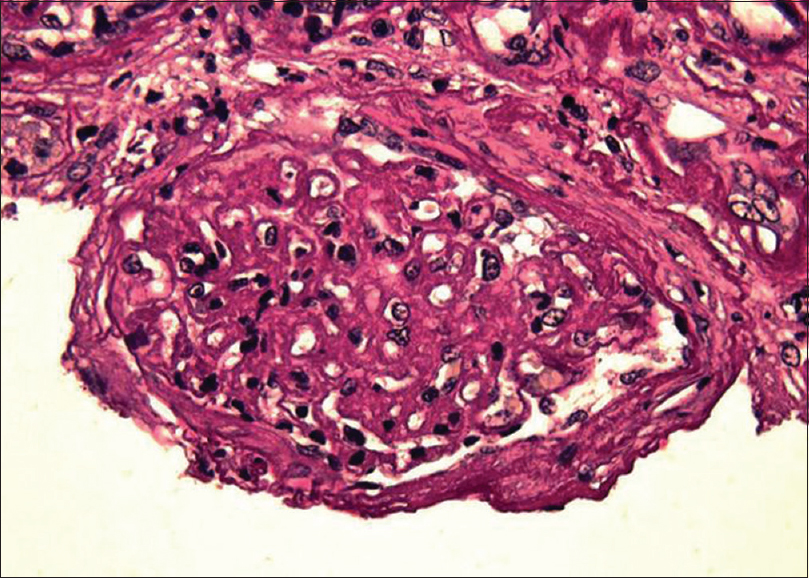Translate this page into:
Membranous glomerulonephritis overlapping with scabies
This is an open access article distributed under the terms of the Creative Commons Attribution-NonCommercial-ShareAlike 3.0 License, which allows others to remix, tweak, and build upon the work non-commercially, as long as the author is credited and the new creations are licensed under the identical terms.
This article was originally published by Medknow Publications & Media Pvt Ltd and was migrated to Scientific Scholar after the change of Publisher.
Sir,
Today, scabies affects to 300 million people worldwide. The disease is strongly associated with wars, migration, poverty and overcrowding.[1] This mites' infestation can predispose affected subjects to kidney disease.[2] In the survey of Hoy and McDonald, in children of 5-17 years the albumin/creatinine ratio correlated significantly with scabies.[3] Occurrence of poststreptococcal glomerulonephritis (PSGN), acute rheumatic fever and systemic sepsis are wellknown complications of scabies infestation.[4] PSGN is the most documented complication of scabies.[5] It has been postulated that antibodies to mite antigens cross-react with basement membrane antigens. There are few histological reports on renal involvement in scabies. A 20-year-old male, born in Somalia, with a previously good health, landed in Italy and was admitted to hospital because of dyspnea, malnutrition (height: 175 cm, weight 47 Kg; BMI: 15.34 Kg/m2) and generalized pruritus. The physical examination revealed diffuse linear excoriations disseminated all over his body and severe edema in the lower extremities. The laboratory examinations showed: proteinuria 7.4 g/day; albumin: 1.18 g/dl; creatinine: 4.02 mg/dl; reactive C-Protein 26.83 mg/dl (n.v. 0-0.3); total leucocyte 21,260/µL; hemoglobin: 6,8 gr/dl; coagulation and liver function tests were unremarkable and other immunological (ASLO, immunoglobulin, extractable nuclear antigens, C3 and C4) and microbiological (hepatitis B virus, hepatitis C virus, HIV, Filaria and Leptospira) investigations were negative. The microscopic investigation of a stool sample showed no abnormal findings. The instrumental examinations showed pleural and pericardial effusion. The dermoscopy demonstrated the mites' infestation. On biopsy, 6 out of 20 glomeruli were globally sclerotic; the remaining glomeruli showed diffuse and global thickening of the capillary wall [Figure 1]; the Jones stain demonstrated the spikes in capillary walls; no vascular or tubulointerstitial lesions were seen. The immunofluorescence examination displayed granular deposition of IgG, IgM and fibrinogen along the glomerular capillary (subepithelial) walls [Figure 2]. These findings supported the diagnosis of a stage III Membranous Gomerulonephritis. The patient was treated with topical treatment of 25% benzyl benzoate, albumin I.V. and furosemide. The Patient improved gradually. After two cycles of topical therapy, we observed the disappearance of itching, creatinine 0.80 mg/dl and proteinuria 2 gr/day. The patient was lost to follow-up because he continued his journey. This neglectedparasitic disease is a major public health problem in resource-poor regions. Dysregulation of the immune system can produce the deposition of immunoimmunoglobulins along the capillary walls. To our knowledge, there are not reports on scabies combined with membranous nephropathy.

- Renal biopsy. Light microscopy: Global and prominent thickening of the glomerular basement membranes. (PAS, ×400)

- Renal biopsy. Immunofluorescence: Diffuse deposition of IgG along the glomerular capillary walls
Financial support and sponsorship
Nil.
Conflicts of interest
There are no conflicts of interest.
References
- Of mites and men: Scabies in patients with kidney disease. Clin Kidney J. 2013;6:125-7.
- [Google Scholar]
- Scabies increased the risk of chronic kidney disease: A 5-year follow-up study. J Eur Acad Dermatol Venereol. 2014;28:286-92.
- [Google Scholar]
- Albuminuria: Marker or target in indigenous populations. Kidney Int Suppl. 2004;92:S25-31.
- [Google Scholar]
- The multidimensional nature of renal disease: Rates and associations of albuminuria in an Australian Aboriginal community. Kidney Int. 1998;54:1296-304.
- [Google Scholar]
- Acute post-streptococcal glomerulonephritis in the Northern Territory of Australia: A review of 16 years data and comparison with the literature. Am J Trop Med Hyg. 2011;85:703-10.
- [Google Scholar]






